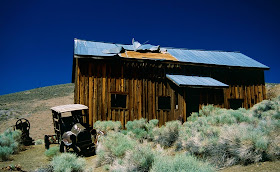I nominate Berlin-Ichthyosaur for America’s oddest-named state park. However, considering that many state parks are named to celebrate either history or scenery—Fremont Indian and Kodachrome Basin State Parks in Utah, for instance—perhaps this remote Nevada state park’s appellation suits it perfectly.
Let’s break down the park’s unusual hyphenated name and unearth the linkage between the two.
First, Berlin:
Given the chance to strike it rich from precious metals mining in the late 1800s, a town and all its infrastructure materialized before you could say “failed gold and silver mine”. The town of Berlin, with it’s less-than-successful production, was born and died in little more than a decade between the late 1890s and early 1900s.
The townsite remained largely ignored for 50 years before being established as a state park in 1957. Today the park service maintains Berlin in a state of “arrested decay”.
The Berlin ghost town tour is a self-guided journey into the past, through old mill sites and homesteads.
The miners left in a hurry when the mills closed, without looking back or taking the time to pack. Furniture, bottles, canned goods, cooking utensils, tools—even a jar of rattlesnake tails—all were left behind in their cabins. Only in a state as dry and sparsely populated as Nevada could these treasures be preserved for visitors to enjoy and discover decades later.
 |
| Berlin Townsite. The buildings from over 100 years ago are well-preserved. Notice the long and lonely entrance to the park. |
 |
| The townspeople even left their cars intact! |
Second, Ichthyosaur:
A vast inland sea once covered most of the state of Nevada. Inhabiting this sea were giant creatures, part fish and part lizard. The sea lizards hung around for 160 million years or so, through the Mesozoic and Jurassic periods, becoming extinct during the late Cretaceous period.
Their bones were covered by thousands of feet of mud and slime, which later hardened into shale and then uplifted. For tens of millions of years the shale eroded, exposing the prehistoric fossilized bones.
Enter those gold and silver miners, a few of whom discovered "rocks" shaped surprisingly like bowls. You guessed it. The peculiar rocks, used by miners as water dishes for their dogs, were later identified as vertebrae from the long-ago fish-lizards.
Dozens of fossilized ichthyosaur skeletons have been excavated near Berlin and thus these two historic sites—one of them 100 years old and the other 100 million years old—are explicitly linked.
 |
| The 60-foot long Ichthyosaurs were abundant and were the largest animals of their time. |
Odd name or not, Berlin-Ichthyosaur State Park is well off the beaten path but worth a visit if you’re traveling through central Nevada.
 |
| Up the road from Berlin townsite the park provides fourteen delightful campsites with sheltered picnic tables. A quarter mile nature trail leads to the fossil quarry. |

Hi Rita . . . what a very interesting and informative blog posting!
ReplyDeleteBerlin-Ichthyosaur is indisputably an oddly-named State Park! And, Berlin is unquestionably a stereotypical desert ghost town. I find it especially amazing that some of the townspeople even left behind their intact cars!
Not only does the State Park have an odd name, but it’s also unusual to have a site linking the ancient past (Ichthyosaur fossils), and the not so ancient past (mining town of Berlin).
Speaking of Berlin, I’m wondering how that name is pronounced locally. Here in New Hampshire our town of Berlin is pronounced as BER-lin (emphasis on 1st syllable), unlike the name of the city in Germany which is pronounced as Ber-LIN (emphasis on 2nd syllable).
John
I agree that the linkage of ancient pre-history and recent history is a fascinating one. Perhaps there are more of these types of pairings, but we don't know about them because we have dynamited or bulldozed the ancient past into oblivion!
DeleteI believe that Berlin townsite is pronounced the same as Germany's Berlin. And also, if I recall correctly, the town is named for the man who discovered the gold and silver in the area.
I appreciate your comments, John!
I've never visited this particular treasure in Nevada, and I wish I had. In fact, let me make that stronger and say that I will. I appreciate the research you do for your posts, Rita; you combine strong description with interesting information in a wonderful and highly readable way. And, once again, your opening and this sentence, "...a town and all its infrastructure materialized before you could say “failed gold and silver mine,” compelled me to read on. Good stuff.
DeleteJanet, first let me say how appreciative I am of your thoughtful critique of this post.
DeleteAnd, second, I'm thrilled that I've inspired you to visit this wonderful Nevada park.
Happy travels!
This definitely looks like off the beaten track, Rita, and I wonder that ancient Ford (it's a Ford, isn't it) could be restored.
ReplyDeleteAnd then, given a few million years more, I also wonder what new creatures could come into existence ...
I think the auto is indeed a Ford and, if the state park would let them I'm sure someone would be interested in restoring it. Some folks in the US spend exorbitant amounts of time and money fixing up old cars. Is that true in India as well?
ReplyDeleteInteresting, Soumyendu, in a few million more years I can't even imagine what the earth and its creatures might look like!
Thanks for your comments!